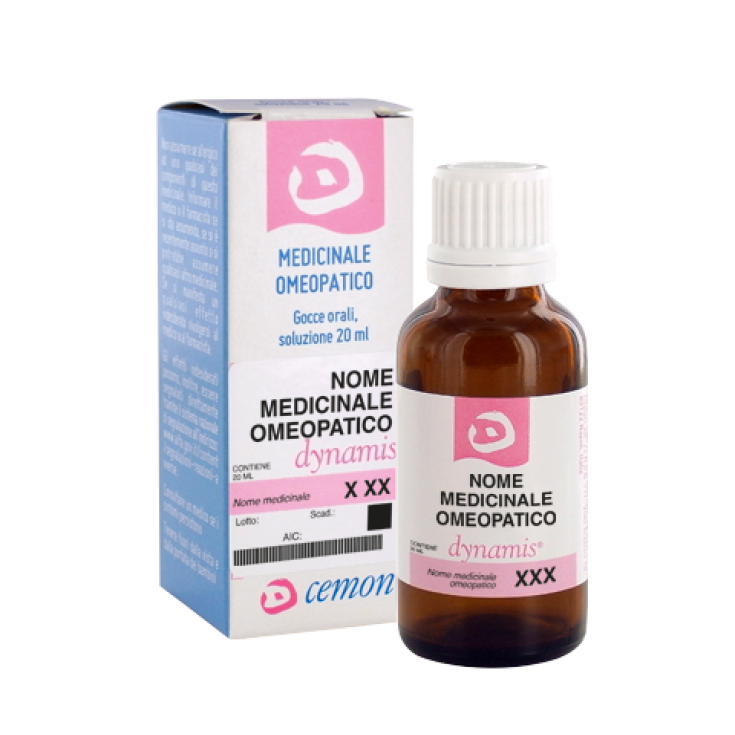Dynamis Ferrum Phosphoricum mk Cemon Drops 10ml

- Brand: CEMON Srl
- Product Code: 800644472
- EAN: 8013901096586
- Availability: Out Of Stock
- Purchase 3 items for 12.57€ each
- Purchase 4 items for 12.32€ each
- Purchase 5 items for 12.06€ each
Dynamis Ferrum Phosphoricum mk Cemon Drops - Homeopathic Medicine
The homeopathic remedy Ferrum phosphoricum is obtained from the trituration and subsequent dilution and dynamization of iron phosphate, a bluish-gray powder insoluble in water and soluble in acids.
Iron phosphate is the iron (III) salt of naturally occurring phosphoric acid in Vivianite, a mineral that covers the fossilized remains of fish and bones.
Iron and phosphorus are present in red blood cells, which have a great affinity for oxygen and which they bind in the lungs; this explains the influence that the remedy also has on the respiratory system. Iron binds inspired oxygen and carries it through the bloodstream to all cells in our body.
What is it for?
Ferrum phosphoricum is a remedy with anti-inflammatory and antipyretic activity, especially a load on the respiratory tract accompanied by low fever with associated asthenia, which is traditionally used in the following cases:
Head congestion, frontal headache, epistaxis. Acute nasopharyngitis with acute congestive ear infections. Laryngitis, tracheitis, bronchitis. Parotid swelling, fever that develops slowly and progressively. Blood loss rashes associated with asthenia and sweating.
Which dilution of granules, single doses or homeopathic drops to choose?
First of all, we remind you that the best thing before embarking on or continuing a treatment with homeopathic remedies is to consult a doctor to evaluate the best therapeutic path.
In homeopathy there is no common rule for all homeopathic remedies and for all pathologies and users. Below we will list a basic rule that can guide the choice of dilution, even if the results and duration of therapy vary for each remedy, for the individual person's ability to react and the type of pathology.
- Low dilutions (those up to 7CH): they have a rapid or very rapid effect, act for a few hours and must be taken at a close distance (every 2 hours, every hour or even for shorter periods) to resolve a pathology with acute symptoms, such as for severe sore throat or headache, for example. They are also suitable for carrying out a "drainage" activity, which stimulates the excretory organs (kidneys, liver, intestines, lungs, skin), freeing the body from toxins and making it more receptive to homeopathic treatment.
- Medium dilutions (such as 9CH or 15CH for example): they have a slightly slower effect, need 1-2 days to act and offer a therapeutic effect of about 10 days.
- Medium-high dilutions (for example 30CH which is a very important dilution, among the most used in homeopathy): they take a few days (from 5 to 10 days) to express their full effectiveness and maintain their therapeutic effects for about 20-30 days. They are mainly used for chronic diseases, for general symptoms and for functional, but they also have an effect on acute symptoms and mental problems
- High dilutions (200CH or 200K): they take a good number of days to act and cover a therapeutic time of about 1 month or more. They have a more systemic and profound action. Generally they are used in chronic pathologies and in those involving the psychological component of the subject. However, a wide use of highly diluted remedies is also made for acute diseases such as sore throats and colds (for example Mercurius 200CH single-dose for sore throat)
- Very high dilutions (first of all 1000CH, MK and XMK): they are deep and powerful remedies (according to the homeopathic tradition), they take many days to express themselves and then therapeutically last a fairly long time. They are often used to scale following the 200CH dilution, following the dosage schedule of use in the order of 200ch, mk (1000k), xmk (10000k), lmk (50000k) and cmk (100000k).
What does the label of a homeopathic medicine mean?
The name of the homeopathic medicine is traditionally in Latin and identifies the raw material used as the basis for the preparation of the Latin remedy. The Latin language was chosen to allow all doctors in the world to recognize the raw material used. The raw material used is generally of vegetable origin, but it can also be of mineral or animal origin.
One of the characteristics of the homeopathic medicine is the dilution. The number indicates the dilution level. For example 5 CH means that the raw material has been diluted 5 times in centesimal dilution, that is 1 part of raw material and 99 parts of solution. The remedy is then dynamized to make the homeopathic medicine.
The two letters CH stand for Hahnemannian Centesimal, or the dilution method developed by Dr. Hahnemann, the founder of homeopathy. If after the number (which can also be written in Roman numerals) the letter K is found, it means that we are dealing with a homeopathic remedy with Korsakovian dilution, that is, developed by Dr. Korsakov, direct student of Dr. Hahnemann. Another type of dilution is DH, which is the Hahnemannian decimal dilution, which is 1 part of raw material and 9 parts of solution.
Method of use or dosage
Traditionally in homeopathy the use of homeopathic remedies is differentiated according to the ailments. As a general line it differs if they are used for chronic problems or for acute problems.
- In the chronic phase it is usually recommended to take 10 to 20 drops 3 times a day, diluted in a little natural water, possibly away from meals or at least 15 minutes away.
- In case of acute pathology, homeopathic drops are usually taken several times during the day at close range, usually it can be taken to 5-10 drops every two hours.
In any case, it is advisable to ask the homeopathic doctor for information on the appropriate dosage and to evaluate the actual need for the homeopathic product or, if necessary, to use another category of medicines.
Is it possible to take homeopathic remedies together with other drugs?
This is also a doubt that patients who are following a homeopathic therapy often ask themselves, generally there are no contraindications to the simultaneous intake of homeopathic products and drugs. Indeed, doctors often associate and recommend these two different therapeutic modalities. There are no interactions during the simultaneous intake of allopathic and homeopathic medicines, however it is advisable to contact your doctor in case of any doubts.
Can homeopathic products be used during pregnancy and breastfeeding?
The period of pregnancy and breastfeeding are a delicate moment in the life of a woman and baby, it is advisable to take any medicine at the doctor's advice. This also applies to homeopathic remedies which, however, thanks to the very diluted active substances present in their compositions, can generally be taken during pregnancy and breastfeeding. Thanks to their tolerability and safety they are increasingly prescribed by gynecologists for minor ailments during pregnancy.However, we remind you once again the need to consult your doctor or gynecologist before embarking on the use of a homeopathic medicine.
Format
10 ml bottle with dropper containing the remedy in hydroalcoholic solution.

